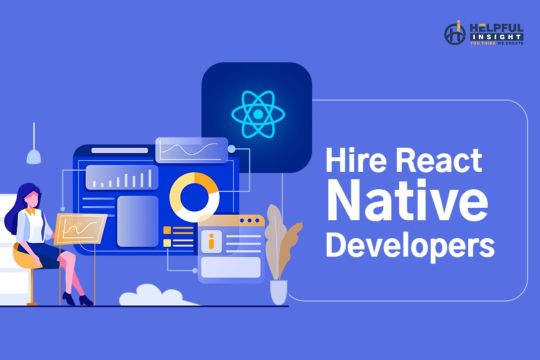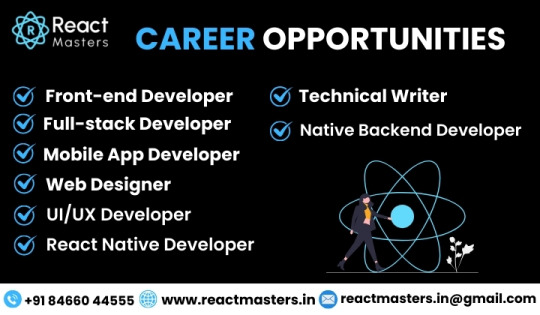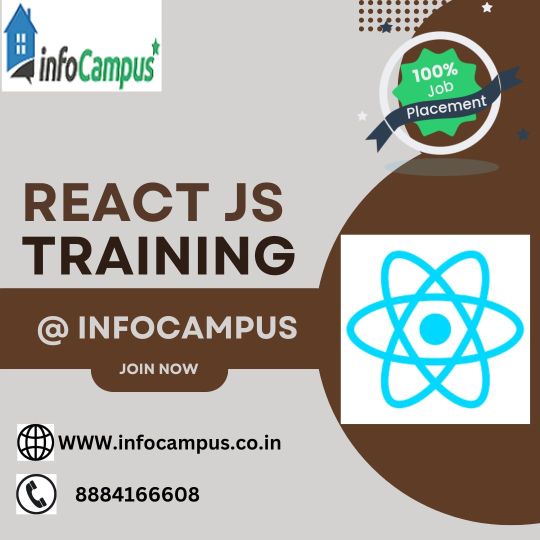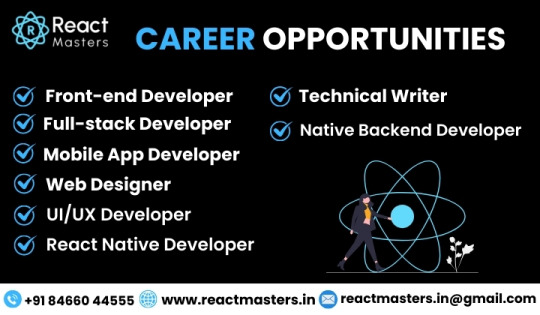#react native freelancer
Explore tagged Tumblr posts
Text
Our team of experts at Helpful Insights is India’s top React native app development company. Our core development team is made up of highly experienced engineers with expertise in React Native, along with state-of-the-art infrastructure and the latest technology. We stand out with our top-quality service, punctuality, and client-oriented approach — making us the industry’s leading company. We constantly aim to surpass the client's expectations; we ensure that their project is completed at a reasonable cost.
Helpful Insight is a mobile app developer company that started its operations in the year 2014 with a strong base in Bharat. The company sought to offer its clients dependable, creative as well and cost-effective solutions in mobility applications. It has done several small and large-scale projects.
Helpful Insight’s team comprises very experienced people with numerous successfully completed projects. As a result, all of its members are well-versed in the domain and use the newest tools to produce excellent results for the clientele.
The team at Helpful Insight is made up of experts in design, development, testing, and deployment issues. Each initiative is finished punctually and with allocated funds. The team is committed to offering user-friendly applications that are easy to operate. Additionally, they verify if the applications operate safely and stably.
helpfulinsightsolution comapny Hire React Native App Developers in India. and provide React native freelance salary for the developers. The rate of the developer is decided on an hourly basis. for more information please visit on the website.

#Hire react native app developers github#Hire react native app developers free#react native developers#hire react native developer india#react native freelance salary#react native freelancer#react native developer jobs#react native developer salary
0 notes
Text
Hire React Native App Developers
YES IT Labs helps you hire React Native app developers for modern, user-friendly mobile apps. Transform your business with tailored solutions from our experts.

#hire react native app developers#hire react native developers#react native freelancer in usa#hire dedicated react native developers#react native developers for hire#hire react native expert
0 notes
Text
Why Should You Develop Your App on the React Native Platform in 2023?
What is react native?
React Native is an open-source framework that enables you to build native mobile apps using JavaScript. It is based on React, a JavaScript library for building user interfaces. React Native uses native components to render the user interface, which means that the app can achieve the same level of performance as a native app.
According to the Stack Overflow Developer Survey 2022, React Native is the 6th most popular framework for mobile development, with 14.51% of respondents using it.
React Native is used by many well-known companies, including Facebook, Instagram, Uber, Walmart, and Bloomberg.
The React Native community is large and active, with over 1 million developers using the framework.
React Native apps can be built for both iOS and Android platforms, which can save businesses time and money.
React Native apps can be developed quickly and easily, with a shorter development time than native apps.
React Native apps can achieve the same level of performance as native apps.
The market share of React Native apps is growing steadily. In 2021, it was estimated that React Native apps accounted for 5.43% of all mobile apps.
The average salary for a React Native developer is higher than the average salary for a mobile developer. In the United States, the average salary for a React Native developer is $90,000.
The demand for React Native developers is high. In 2022, there were over 100,000 job openings for React Native developers.
Reason why businesses should adopt react native?
There are many reasons why you should develop your app on the React Native platform in 2023. Here are some of the most important ones:
Faster development time: React Native allows you to build native mobile apps using JavaScript, which means that you can share code between platforms. This can significantly reduce your development time and costs.
Native performance: React Native apps are rendered using native components, which means that they can achieve the same level of performance as native apps.
Large community: React Native has a large and active community of developers, which means that there are a lot of resources available to help you learn and use the framework.
Easy to learn: React Native is based on JavaScript, which is a popular and well-known language. This makes it easy for developers to learn and use React Native.
Hot reloading: Hot reloading is a feature of React Native that allows you to make changes to your code and see the results immediately in the app. This can save you a lot of time when debugging and developing your app.
Flexible: React Native is a flexible framework that can be used to build a wide variety of mobile apps. This makes it a good choice for businesses of all sizes.
Overall, React Native is a powerful and versatile framework that can help you build high-quality mobile apps quickly and easily. If you are considering developing a mobile app in 2023, React Native is a great option to consider.
How react native is different from other frameworks?
React Native stands out from other frameworks for mobile app development in a number of ways, including:
Cross-platform development: React Native allows you to build native mobile apps for both iOS and Android using the same codebase. This can save businesses time and money, as they don't need to develop two separate apps.
Native performance: React Native apps are rendered using native components, which means that they can achieve the same level of performance as native apps. This is important for apps that require a lot of user interaction or graphics.
Large community: React Native has a large and active community of developers, which means that there are a lot of resources available to help you learn and use the framework. This can be especially helpful if you are new to React Native.
Easy to learn: React Native is based on JavaScript, which is a popular and well-known language. This makes it easy for developers to learn and use React Native, even if they don't have experience with mobile app development.
Hot reloading: Hot reloading is a feature of React Native that allows you to make changes to your code and see the results immediately in the app. This can save you a lot of time when debugging and developing your app.
Flexibility: React Native is a flexible framework that can be used to build a wide variety of mobile apps. This makes it a good choice for businesses of all sizes.
What types of apps can be developed with react native framework?
React Native is a versatile framework that can be used to build a wide variety of mobile apps. Some of the most common types of apps that are built with React Native include:
Social media apps: React Native is a popular choice for building social media apps because it allows you to build native-like user interfaces that are responsive and performant. Some popular social media apps that are built with React Native include Facebook, Instagram, and Pinterest.
E-commerce apps: React Native is also a good choice for building e-commerce apps because it allows you to build complex user interfaces with a lot of interactivity. Some popular e-commerce apps that are built with React Native include Shopify and Wish.
Gaming apps: React Native can be used to build high-performance gaming apps that are both visually appealing and engaging. Some popular gaming apps that are built with React Native include PUBG Mobile and Temple Run 2.
Business apps: React Native is a good choice for building business apps because it allows you to build apps that are both user-friendly and scalable. Some popular business apps that are built with React Native include Uber and Airbnb.
Media apps: React Native can be used to build media apps such as streaming apps, music players, and photo editing apps. Some popular media apps that are built with React Native include Netflix, Spotify, and VSCO.
Conclude
These are just a few of the many types of apps that can be built with React Native. If you are considering developing a mobile app, React Native is a great option to consider. It is a powerful and versatile framework that can help you build high-quality apps quickly and easily.
#mobileappdeveloper#freelance mobile app developer#iosappdeveloper#androidappdeveloper#appdeveloper#appdevelopmentservices#hire freelance mobile app developer#mobile app development#react native#react native app developer
0 notes
Text
How Much Does React Native App Development Cost in California?

With the growing demand for mobile applications, businesses are increasingly opting for cross-platform solutions like React Native to reduce development time and costs. California, being a tech hub, has a vibrant ecosystem of app development companies, but the cost of development can vary significantly based on several factors. In this blog, we’ll explore the cost of React Native app development in California and what influences the pricing.
Factors Influencing React Native App Development Cost
1. Complexity of the App
The complexity of your app plays a crucial role in determining the cost. Apps can be categorized into three levels of complexity:
Simple Apps – Basic apps with minimal features, such as a calculator or to-do list. ($10,000 - $30,000)
Medium Complexity Apps – Apps with additional functionalities like user authentication, API integration, and database management. ($30,000 - $80,000)
Complex Apps – Feature-rich apps with real-time data sync, AI, AR/VR, or blockchain integration. ($80,000 - $200,000+)
2. UI/UX Design
An intuitive and appealing UI/UX is essential for user engagement. Custom designs and animations can increase costs but significantly improve user experience. UI/UX design costs in California typically range from $5,000 to $30,000depending on complexity.
3. Development Team
Hiring a development team in California is costlier than in many other regions due to high labor costs. The pricing varies based on the team’s experience:
Freelancers – $30 - $100 per hour
Small Agencies – $50 - $150 per hour
Established Development Firms – $100 - $250 per hour
4. Backend Development & Third-Party Integrations
If your app requires a strong backend, the cost increases. Cloud-based solutions like AWS, Firebase, or custom-built servers influence pricing. Additionally, integrating third-party services (payment gateways, APIs, analytics tools) can add $5,000 - $50,000 to the development cost.
5. Maintenance & Updates
Post-launch maintenance is essential for app stability. Maintenance costs can range from 15-20% of the total development cost per year to fix bugs, update features, and ensure compatibility with the latest OS versions.
Estimated Cost Breakdown for React Native App Development in California
Basic App Development - $10,000 - $30,000
Medium Complexity App - $30,000 - $80,000
Complex App Development - $80,000 - $200,000+
UI/UX Design$5,000 - $30,000
Backend & Integrations - $5,000 - $50,000
Maintenance (Annual) - 15-20% of dev cost
Ways to Reduce React Native App Development Cost
Prioritize MVP Development – Focus on a Minimum Viable Product (MVP) to validate the idea before investing heavily.
Outsource Development – Hiring offshore or nearshore teams can reduce costs while maintaining quality.
Utilize Pre-built Solutions – Use pre-existing UI components and third-party integrations to speed up development.
Choose a Cost-effective Development Partner – Partnering with an experienced yet cost-effective development firm ensures quality without overspending.
Final Thoughts
React Native app development costs in California can vary widely based on complexity, team expertise, and required features. While it’s a cost-effective alternative to native development, strategic planning is essential to optimize the budget. If you’re considering building a React Native app, consult a reputable development firm to get a tailored cost estimate based on your specific needs.
Need help with React Native app development? Contact us today for a free consultation!
#app development company in California#mobile app development company in California#app development company California#mobile app developer in California#app developer in California
2 notes
·
View notes
Text

React JS continues to be one of the most in-demand skills in web development, and its popularity is expected to grow even more in 2025. If you’re planning to take a React JS course, here’s a look at the career opportunities and job prospects available in the coming year.
1. Why React JS is a Valuable Skill in 2025?
React JS is widely used by companies of all sizes due to its efficiency, flexibility, and strong community support.
Some key reasons why React JS will continue to be valuable in 2025 include:
✅ High demand for interactive and dynamic web applications
✅ Strong job market with high-paying opportunities
✅ Used by top companies like Facebook, Netflix, Airbnb, and Uber
✅ Growing ecosystem with Next.js, React Native, and more
2. Top Career Roles for React JS Developers in 2025
After completing a React JS course, you can apply for multiple job roles, such as:
🔹 React JS Developer – Develop front-end applications using React. 🔹 Full-Stack Developer – Work with React on the front-end and Node.js or other backend technologies. 🔹 Frontend Engineer – Specialize in user interface (UI) development and UX enhancements. 🔹 React Native Developer – Build mobile applications for iOS and Android using React Native. 🔹 UI/UX Developer – Focus on designing user-friendly and interactive interfaces. 🔹 Software Engineer – Use React alongside other frameworks and technologies in web applications. 🔹 JavaScript Developer – Work on both React and other JavaScript-based technologies.
3. Industries Hiring React JS Developers
React JS is used across multiple industries, creating diverse career opportunities in: 🏦 FinTech – Banking apps, trading platforms, and payment gateways. 🛍 E-Commerce – Online shopping platforms, marketplaces, and payment systems. 🎮 Gaming – Web-based and interactive gaming applications. 📺 Streaming Services – Video and music platforms like Netflix, Spotify, and YouTube. 🏥 Healthcare – Medical applications and patient management systems. 🚀 Startups & Tech Giants – Companies looking for scalable and fast applications.
4. Salary Trends for React JS Developers in 2025
The salary for React developers varies based on experience and location. Here’s an estimate of average salaries in 2025:
📌 Entry-Level (0-2 years):
India: ₹4 - 8 LPA
USA: $60k - $80k per year
UK: £35k - £50k per year
📌 Mid-Level (3-5 years):
India: ₹8 - 15 LPA
USA: $80k - $120k per year
UK: £50k - £70k per year
📌 Senior-Level (5+ years):
India: ₹15 - 30 LPA
USA: $120k - $180k per year
UK: £70k - £100k per year
📌 Freelance React Developer:
Hourly rates range between $30 - $100+ depending on expertise and project complexity.
📌 Factors Affecting Salary:
Location (Salaries are higher in metro cities like Bengaluru, San Francisco, London)
Company size and reputation
Additional skills (Next.js, React Native, TypeScript, Backend knowledge)
Industry demand and project experience
💡 Tip: Learning advanced React concepts and full-stack skills can significantly boost salary potential! 🚀
5. How to Build a Successful Career in React JS?
📌 Learn React Basics – Master JSX, components, state, and props. 📌 Understand React Hooks & State Management – Use useState, useEffect, and libraries like Redux or Zustand. 📌 Practice by Building Projects – Gain hands-on experience with real-world applications. 📌 Learn Next.js – Enhance React knowledge with server-side rendering and static site generation. 📌 Stay Updated with Latest Trends – Follow React’s official documentation, community forums, and blogs. 📌 Get Certified – A React certification can improve your resume and job prospects. 📌 Apply for Internships & Jobs – Start with small projects or internships to gain industry exposure.
6. Future of React JS in 2025 and Beyond
React JS will continue to dominate the frontend development landscape, with growing adoption in: 🚀 AI-powered applications 🚀 Progressive Web Apps (PWAs) 🚀 Server-Side Rendering (SSR) with Next.js 🚀 React Native for Mobile App Development 🚀 Web3 & Blockchain-based applications
With continuous updates and new features, React will remain a top choice for developers and companies in 2025 and beyond.
Final Thoughts
A React JS course in 2025 can open doors to high-paying jobs and career growth opportunities. With its vast ecosystem and strong industry demand, learning React is a smart investment for developers looking to build a successful future in web and mobile development.
💬 Are you planning to learn React? Drop your questions in the comments!
#ReactJS#WebDevelopment#FrontendDevelopment#LearnReact#CareerOpportunities#ReactJobs#FullStackDevelopment#JavaScript#TechCareer
0 notes
Text
The Ultimate Guide to a React JS Course

With the growing demand for dynamic web applications, React.js has become one of the most sought-after JavaScript libraries for building user interfaces. Whether you are a beginner or an experienced developer looking to expand your skill set, enrolling in a React.js course can be a game-changer. This guide will provide a comprehensive overview of what a React.js course entails and why learning React can elevate your career.
What is React.js?
React.js is an open-source JavaScript library developed by Facebook for building interactive and high-performance user interfaces, especially for single-page applications (SPAs). It allows developers to create reusable UI components, manage application state efficiently, and ensure a seamless user experience.
Why Learn React.js?
React.js is widely used in the industry due to its numerous advantages:
Component-Based Architecture – React follows a modular approach, making code more reusable and maintainable.
Virtual DOM – React updates only the necessary parts of the UI, resulting in improved performance and faster rendering.
Strong Community Support – React has extensive documentation, third-party libraries, and active developer support.
Demand in the Job Market – React is a popular skill among employers, opening doors to high-paying job opportunities.
Flexibility – React can be used for web applications, mobile applications (React Native), and even desktop applications.
Key Topics Covered in a React.js Course
A React.js course typically covers the following essential concepts:
Fundamentals of React.js
Introduction to React.js and its ecosystem
Setting up a development environment
Understanding JSX (JavaScript XML)
Components, Props, and State Management
Handling Events and Lifecycle Methods
Event Handling in React
Understanding Functional and Class Components
React Component Lifecycle Methods
State Management in React
Using React Hooks (useState, useEffect, useContext)
State lifting and prop drilling
Introduction to Redux for global state management
Context API for managing state without Redux
React Routing and Navigation
React Router for navigation
Dynamic routing and nested routes
Protected routes and authentication
Working with APIs and Asynchronous Operations
Fetching data with Fetch API and Axios
Handling Promises and Async/Await
Managing API responses and error handling
Advanced React Concepts
Performance optimization with React.memo and useMemo
Lazy loading and code splitting
Higher-Order Components (HOC) and Render Props
Testing in React
Introduction to Jest and React Testing Library
Writing unit and integration tests
Debugging and handling errors
Deployment and Best Practices
Building and optimizing production-ready React applications
Hosting React applications using Netlify, Vercel, and Firebase
Continuous Integration/Continuous Deployment (CI/CD) workflows
Who Should Enroll in a React.js Course?
A React.js course is suitable for:
Beginners in Web Development – Those looking to start their journey in frontend development.
Frontend Developers – Developers familiar with JavaScript who want to specialize in React.
Backend Developers – Those who wish to learn frontend technologies to become Full Stack Developers.
Entrepreneurs & Freelancers – Individuals looking to build dynamic web applications efficiently.
Students & Career Changers – Those seeking a career in web development with in-demand skills.
How to Choose the Right React.js Course?
Take into account the following elements when choosing a React.js course:
Course Curriculum – Ensure it covers both fundamentals and advanced topics.
Hands-on Projects – Look for a course that includes real-world projects and practical applications.
Instructor Expertise – Check if the instructor has industry experience and strong teaching skills.
Certification & Job Support – Some courses offer certification and career assistance, which can be beneficial.
Flexibility – Online, part-time, or full-time options should fit your schedule.
Career Opportunities After Learning React.js
After completing a React.js course, you can explore various job roles, such as:
React Developer – Specializing in building React applications.
Frontend Developer – Working with UI/UX and JavaScript frameworks.
Full Stack Developer - This role combines backend technologies like Node.js with React.J.S.
Software Engineer – Developing scalable web applications.
Freelance Developer – Building applications for clients or personal projects.
Conclusion
A React.js course is an excellent investment for anyone looking to master modern web development. By learning React, you gain the ability to build fast, scalable, and maintainable applications that are widely used across industries. Whether you are a beginner or an experienced developer, React skills can help you land high-paying jobs and grow your career.
Transform your career with React Training in Marathahalli, offered by Infocampus. This comprehensive course is designed to equip you with the essential skills needed to excel in the fast-paced world of web development. Master the powerful React framework and learn how to build dynamic, high-performance applications that stand out. For more details Call: 8884166608 or 9740557058
Visit: https://infocampus.co.in/reactjs-training-in-marathahalli-bangalore.html
0 notes
Text
What to Look for When Hiring a Software Development Provider
What to Look for When Hiring a Software Development Provider
Introduction
In today’s digital world, having the right software solutions can be the key to business success. Whether you're a startup looking to build an innovative app or an established company needing custom software, choosing the right software development provider is crucial. The wrong choice can lead to delays, budget overruns, and a product that doesn’t meet your expectations. But with so many options available—freelancers, development agencies, and offshore teams—how do you choose a software developer that fits your needs?
This guide will walk you through everything you should consider when hiring a software development company, from technical expertise to project management, ensuring you find the best software development services for your business.
1. Define Your Project Needs and Goals
Before you start looking for a software development agency, you need to have a clear understanding of your project. Ask yourself:
What problem does the software need to solve?
What features and functionalities are essential?
What is your budget and timeline?
Do you need ongoing maintenance and support?
Having clear answers to these questions will help you communicate your vision effectively and ensure that the software development company you hire can deliver what you need.
2. Evaluate Technical Expertise and Experience
Not all software development providers have the same level of expertise. When evaluating potential candidates, consider:
Technology Stack
Check if the company specializes in the technologies you need. For example:
Web development: React, Angular, Node.js
Mobile apps: Swift (iOS), Kotlin (Android), Flutter, React Native
Enterprise solutions: Java, .NET, Python
Cloud computing: AWS, Azure, Google Cloud
If your project requires AI, blockchain, or IoT, ensure the software development agency has relevant experience in those areas.
Industry Experience
A software development company with experience in your industry will understand your specific challenges. For example, a provider that has built healthcare applications will be familiar with compliance regulations like HIPAA, while a fintech software developer will know security protocols like PCI-DSS.
Portfolio and Case Studies
A reputable software development provider should have a strong portfolio showcasing their past projects. Look for:
Case studies that highlight challenges and solutions
Live apps or platforms they have developed
Testimonials from previous clients
3. Assess Communication and Project Management
Even the most skilled software development company can fail if communication is poor. Look for a team that:
Is responsive: Do they reply to emails and messages promptly?
Uses clear processes: Do they follow Agile, Scrum, or Kanban methodologies?
Provides regular updates: Will they offer weekly reports, sprint reviews, or demo sessions?
Has a dedicated project manager: A PM ensures smooth communication between you and the development team.
Red Flag: If a company is vague about deadlines, doesn’t provide clear deliverables, or takes days to respond, it may lead to project delays.
4. Check Client Reviews and Reputation
Online reviews can reveal a lot about a software development agency. Check platforms like:
Clutch and GoodFirms for verified client reviews
LinkedIn for testimonials from professionals
Google Reviews and Trustpilot for overall ratings
If possible, contact previous clients to get direct feedback about their experience with the company.
5. Consider Pricing and Engagement Models
Pricing structures can vary depending on the software development provider. Here are the most common engagement models:
Fixed Price
Best for small, well-defined projects
Clear scope, budget, and timeline from the start
Less flexibility for changes
Time & Material (T&M)
Pay for actual work done (hourly or daily rates)
More flexibility to modify requirements
Suitable for evolving projects
Dedicated Team
A full-time team assigned exclusively to your project
Best for long-term development needs
Allows deeper integration with your in-house team
Always compare pricing, but don’t choose a provider based solely on cost. A cheaper software development agency may cut corners, leading to higher expenses later.
6. Test Their Problem-Solving Abilities
Technical skills are essential, but a great software development provider also needs strong problem-solving abilities. During the hiring process, ask:
How do you handle unexpected challenges in a project?
Can you provide an example of a difficult technical problem you solved?
What strategies do you use to ensure code quality and scalability?
This helps gauge their ability to think critically and adapt to real-world situations.
7. Discuss Post-Launch Support and Maintenance
Software development doesn’t end at launch. Ongoing support ensures your software remains functional, secure, and up to date. Ask about:
Bug fixes and troubleshooting: Will they provide free fixes for a certain period?
Updates and enhancements: How do they handle software upgrades?
Support availability: Is there 24/7 support, or only during business hours?
A reliable software development company will offer a clear post-launch support plan.
8. Ensure They Follow Security and Compliance Standards
Security is critical, especially if your software handles sensitive data. Make sure the provider:
Uses secure coding practices
Follows GDPR, HIPAA, or other industry regulations
Implements encryption and authentication protocols
Conducts regular security audits
Ignoring security can lead to data breaches, legal issues, and reputational damage.
Conclusion
Hiring the right software development provider is a crucial decision that can impact your business for years to come. By defining your project needs, evaluating technical expertise, ensuring effective communication, and considering pricing and support models, you can find the best software development services for your needs.
0 notes
Text

🚀 Future-Proof Your Career with React JS Training! 🔥
The world of web development is evolving fast, and React JS is leading the way! If you're a student or aspiring developer looking for a high-paying, in-demand career, then learning React JS is your ultimate gateway to success!
💡 Why Choose React JS for Your Career Path?
✅ High Demand & Job Opportunities – Top companies like Facebook, Instagram, Netflix, and Airbnb rely on React for their web apps! ✅ Fast Learning Curve – Even if you’re new to JavaScript, React is beginner-friendly and easy to master. ✅ Better Salaries – React developers earn some of the highest salaries in the industry! 💰 ✅ Versatile & Future-Ready – React is used in web, mobile, and even VR development (React Native & React 360). ✅ Strong Community Support – A massive developer community and countless resources to help you grow.
🎯 Career Opportunities with React JS Training
🔹 Front-End Developer – Build interactive and dynamic web applications. 🔹 Full-Stack Developer – Master both front-end and back-end development. 🔹 React Native Developer – Create mobile apps with React skills. 🔹 UI/UX Developer – Design smooth and user-friendly interfaces. 🔹 Freelancer / Remote Developer – Work from anywhere and earn globally.
💼 React Developers are in HIGH DEMAND! Companies are hiring, and you can be their next big asset! 🚀
👉 Start Your React JS Training Today & Unlock Limitless Career Opportunities!
#ReactJSCareer#WebDevelopment#LearnReact#ReactForBeginners#FrontendDevelopment#CareerGrowth#TechJobs#ReactJS#CodeYourFuture#react js online training#placement service#job support#web design
0 notes
Text
Best Short IT Courses in Faisalabad to Kickstart Your Tech Career
Faisalabad, known as the industrial hub of Pakistan, is rapidly growing in the field of Information Technology (IT). With the increasing demand for digital skills, many institutes in Faisalabad now offer short IT courses that can help individuals boost their careers in a short time. These courses provide hands-on training and certifications, making them ideal for students, job seekers, and professionals looking to upgrade their skills.
Why Choose a Short IT Course?
Short IT courses are designed to provide specialized knowledge in a limited time. Whether you are a beginner or an experienced professional, these courses can help you:
Gain technical skills quickly
Improve job prospects
Start freelancing or remote work
Keep up with industry trends
Popular Short IT Courses in Faisalabad
Here are some of the best short IT courses you can enroll in:
1. Web Development
Learn HTML, CSS, JavaScript, and WordPress
Duration: 3 to 6 months
Ideal for beginners and aspiring web designers
2. Graphic Designing
Covers Adobe Photoshop, Illustrator, and Canva
Duration: 2 to 4 months
Perfect for creative individuals interested in design
3. Digital Marketing
Includes SEO, Social Media Marketing, and Google Ads
Duration: 2 to 3 months
Suitable for entrepreneurs and marketers
4. Video Editing & Animation
Learn Adobe Premiere Pro, After Effects, and Motion Graphics
Duration: 3 to 5 months
Great for content creators and YouTubers
5. Cybersecurity & Ethical Hacking
Covers network security, penetration testing, and ethical hacking
Duration: 3 to 6 months
Ideal for those interested in IT security careers
6. Mobile App Development
Learn Android and iOS app development using Flutter or React Native
Duration: 4 to 6 months
Suitable for those who want to build mobile applications
7. Freelancing & E-commerce
Covers platforms like Fiverr, Upwork, and Shopify store management
Duration: 1 to 2 months
Best for individuals looking to earn online
Top Institutes Offering IT Courses in Faisalabad
Several reputable institutes provide short IT courses, including:
EVS Training Institute
Aptech Computer Education
NICON Institute
Punjab Skills Development Fund (PSDF) Programs
Government Technical Training Institute (GTTI)
Conclusion
Investing in an IT course can open doors to new opportunities. Whether you want to start a career, switch fields, or begin freelancing, these short IT courses in Faisalabad can help you achieve your goals. Find a course that matches your interests and take the first step toward a successful tech career today.
1 note
·
View note
Text
App Development Services,
App Development Services,
In today’s digital-first world, mobile applications have become essential for businesses and individuals alike. From streamlining processes to enhancing customer experiences, app development plays a critical role in almost every industry. Whether you're a startup looking to create an innovative solution or a large enterprise aiming to expand your digital footprint, professional app development services offer the expertise needed to turn ideas into reality.
What Are App Development Services?
App development services refer to the end-to-end solutions offered by development companies or freelance professionals to build mobile applications. These services cover everything from initial consultation and ideation to design, development, testing, and deployment. Whether you're creating an app for iOS, Android, or cross-platform, developers use cutting-edge technology to deliver user-friendly and scalable solutions.
Key Stages of App Development
Consultation and Idea Refinement Every successful app starts with a great idea. App developers work with clients to refine their ideas, identify the target audience, and understand the problem they aim to solve. In this stage, developers assess the market, determine the app's core features, and outline the project's scope.
UI/UX Design The design of the app is crucial to user retention and overall success. Designers focus on creating an intuitive interface and smooth user experience, ensuring the app is not only visually appealing but also easy to navigate. User research and wireframing are key parts of this stage.
Development The actual coding and programming of the app begin. Developers use programming languages like Swift (for iOS), Kotlin (for Android), and JavaScript (for cross-platform) to bring the app’s design to life. At this stage, both frontend (user-facing) and backend (server-side logic) development take place.
Testing and Quality Assurance To ensure the app functions properly across different devices and environments, thorough testing is essential. Quality assurance specialists test the app for bugs, performance issues, and usability problems. This includes functional testing, security testing, and user acceptance testing (UAT).
Deployment Once the app passes testing, it’s ready for launch. The app is deployed to app stores like the Apple App Store or Google Play Store. Developers also handle the submission process, ensuring the app meets store guidelines.
Maintenance and Updates After the app is live, ongoing maintenance is required. Regular updates, bug fixes, and new feature additions are necessary to keep the app running smoothly and to improve user experience.
Types of Apps Developed
Native Apps: Built specifically for one platform, either iOS or Android. Native apps provide superior performance and a seamless experience but require separate development for each platform.
Cross-Platform Apps: These apps are built to function on multiple platforms, such as iOS and Android, using a single codebase. Frameworks like React Native or Flutter make this possible and are an excellent choice for companies looking to save on development time and cost.
Web Apps: These apps are accessed through a web browser and do not require downloading. They are often used for businesses that need a presence across devices without developing multiple apps.
Hybrid Apps: A mix of native and web apps, hybrid apps combine the benefits of both. They are built with web technologies but wrapped in a native container to enable installation on mobile devices.
Why Choose Professional App Development Services?
Expertise and Experience: Professional developers have the skills and experience to build high-quality, robust, and scalable applications. They are familiar with the latest industry trends, tools, and technologies, ensuring your app stands out in a competitive market.
Cost Efficiency: While hiring a professional development team might seem expensive upfront, it can save money in the long run. A well-built app reduces the need for constant revisions and fixes, while an expert team can optimize the development process to be more cost-effective.
Faster Time to Market: With an experienced team, you can speed up the app development process without sacrificing quality. This is crucial in today’s fast-paced business environment, where getting your product to market quickly can make all the difference.
Post-launch Support: After the app is launched, a professional development service offers ongoing maintenance and updates. This ensures your app stays relevant and functional, adapting to any changes in operating systems, technologies, or user preferences.
Choosing the Right App Development Company
When selecting an app development service provider, it’s essential to consider several factors:
Portfolio and Experience: Review their past projects to ensure they have experience in developing apps similar to yours.
Development Process: Understand their approach to development, communication, and how they handle client feedback.
Customer Reviews and Testimonials: Check reviews from previous clients to gauge the quality of their work and customer satisfaction.
Support and Maintenance: Ensure they provide comprehensive post-launch support, including bug fixes, updates, and troubleshooting.
Conclusion
In a world where mobile applications are central to business success, choosing the right app development service is a critical step in bringing your vision to life. Whether you're looking to build a game-changing product or improve your company’s mobile presence, working with experienced developers ensures that your app will be scalable, secure, and successful in the market. From consultation to launch and beyond, app development services are your partners in turning digital dreams into reality.
4o mini
0 notes
Text
Top Frameworks for Cross-Platform App Development in 2025
The best cross-platform frameworks in 2025 will help you develop apps that run smoothly on all platforms while saving time, cost, and resources.

#cross-platform app development framework#native ARM code#nativescript vs react native#custom website development service#mobile applications developers#web developer freelancers
0 notes
Text
Which Course is the Best in IT?

IT is a fast-booming industry, giving many career options to those interested in technology. For beginners looking forward to entering the IT world, and for those wanting to upgrade their knowledge, choosing the right IT course is very essential for their careers.
At Sovorun Academy, we know that industry-specific skills are what matters, and we offer the best IT courses to match the needs of the market. In this blog, we will look at the best IT courses so you can make an informed decision.
Why Choose a Career in IT?
The demand for IT professionals has been rapidly increasing in India. With the ever-growing trend of digital transformation within the world of businesses, there is a definite need for skilled IT experts in various industries. IT course provides such an opportunity that can lead to high-paid jobs, freelance work, and eventually even entrepreneurship.
Benefits of Pursuing an IT Course
Work from home and freelance options
Best IT Courses to Advance Your Career
High-paying job opportunities
Top IT Courses to Boost Your Career
1. Full Stack Web Development
Full Stack Web Development is one of the most in-demand courses for IT. You learn front-end and backend technologies, allowing you to build a whole application from start to finish.
Key Skills: HTML, CSS, JavaScript, React, Node.js, MongoDB.
Career Roles: Web Developer, Full Stack Developer, UI/UX Designer.
2. Data Science & Artificial Intelligence (AI)
Data Science and AI are revolutionising industries worldwide. This course focuses on data analysis, machine learning, and AI-driven solutions.
Key Skills: Python, Machine Learning, Data Visualisation, AI Algorithms.
Career Roles: Data Scientist, AI Engineer, Business Analyst.
3. Cybersecurity & Ethical Hacking
With increasing cyber threats, companies require skilled cybersecurity experts to protect their digital assets. Ethical hacking is a sought-after skill in the IT industry.
Key Skills: Network Security, Ethical Hacking, Cryptography, Risk Management.
Career Roles: Cybersecurity Analyst, Ethical Hacker, Security Consultant .
4. Mobile App Development
The mobile app industry is booming, and skilled developers are in demand. This course covers Android and iOS app development using popular frameworks.
Key Skills: Flutter, React Native, Kotlin, Swift .
Career Roles: Mobile App Developer, Software Engineer, UI/UX Designer .
5. Cloud Computing & DevOps
Cloud Computing is the backbone of modern IT infrastructure. Learning DevOps and Cloud technologies can enhance your career prospects considerably.
Key Skills: AWS, Azure, Kubernetes, Docker, CI/CD Pipelines.
Career Roles: Cloud Engineer, DevOps Engineer, System Administrator.
Which IT Course is Best for You?
The best IT course for you would be the one that suits your interest and career goals. If you enjoy coding, Full Stack Development or Mobile App Development might be perfect. If you are interested in AI and data, Data Science would be the way to go. For those who have a passion for cybersecurity, Ethical Hacking is the best option.
At Sovorun Academy, we offer expert guidance to help you choose the right IT course based on your strengths and aspirations.
Why Choose Sovorun Academy?
Industry-Relevant Curriculum – Learn the latest technologies used in the IT industry.
Hands-on Training – Work on real-world projects and case studies.
Expert Mentors – Learn from experienced IT professionals.
Job Support – Get career guidance and placement support.
Flexible Learning – Online and offline classes available.
Take the First Step Towards Your IT Career!
The IT industry offers a wide variety of opportunities. The right course can set you off on a track to success, whether it's to become a developer, data scientist, or cybersecurity expert. Sovorun Academy is perfect for every course in the IT industry.
Join our community and start your IT journey now!
At Sovorun Academy, we are committed to providing world-class IT education to help you succeed in this competitive industry. Start your IT journey with ustoday!
0 notes
Text
Hire Dedicated Developers in India to Boost Your Startup
Startups often face a monumental challenge: finding skilled developers while managing costs effectively. Building an in-house team can be expensive and time-consuming, especially for early-stage companies. That’s where the decision to hire dedicated developers in India becomes a game-changer.
In this blog, I’ll explore why India is a top destination for hiring developers, how startups can benefit, and actionable steps to find the right talent. From cost savings to flexibility, you’ll discover everything you need to supercharge your startup’s growth with India’s rich tech talent pool.

Why Hire Dedicated Developers in India?
1. Cost-Effectiveness
One of the primary reasons startups choose to hire Indian developers is the significant cost savings. Compared to hiring developers in the US, UK, or Europe, Indian developers provide high-quality services at a fraction of the cost.
Cost Comparison:
In-house developers (US): $100,000 to $150,000/year (including benefits and infrastructure).
Dedicated developers in India: $25,000 to $50,000/year.
By outsourcing to India, startups can save up to 70% on development costs while still maintaining high-quality deliverables.
2. Access to a Large Pool of Skilled Talent
India is home to a vast number of highly skilled developers. With over 1.5 million engineering graduates every year and a booming IT industry, the country offers expertise in:
Web development (React.js, Angular, Node.js).
Mobile app development (iOS, Android, Flutter, React Native).
Emerging technologies (AI, ML, Blockchain, IoT).
The competitive nature of the Indian IT sector ensures that developers are continuously upgrading their skills to stay relevant.
3. Improved Time-to-Market
Hiring dedicated developers in India can help startups launch products faster. Indian developers are known for their ability to adapt quickly and work efficiently. With their expertise and dedication, startups can:
Scale projects quickly.
Reduce development cycles.
Meet tight deadlines.
Additionally, the time zone difference between India and Western countries allows for round-the-clock development, ensuring faster turnaround times.
4. Focus on Core Business Activities
Outsourcing your development needs allows you to focus on strategic business activities, such as:
Marketing.
Sales.
Product strategy.
By delegating technical tasks to skilled professionals, startups can concentrate on growth and scaling.
5. Flexibility and Scalability
Startups often need to scale their development teams up or down depending on project requirements. Hiring developers in India offers unparalleled flexibility:
Quickly onboard developers with specific skills.
Scale down without worrying about layoffs or office space.
Adapt to changing project needs with ease.
How to Hire Dedicated Developers in India
1. Choosing the Right Hiring Model:
Depending on your needs, you can choose from various hiring models:
Direct Hiring:
Pros: Full control over the hiring process and team management.
Cons: Time-consuming and may require additional resources for recruitment.
IT Outsourcing Companies:
Pros: Access to pre-vetted, skilled developers with minimal effort.
Cons: Slightly higher costs compared to direct hiring.
Freelance Platforms:
Pros: Budget-friendly and flexible.
Cons: Lack of accountability and potential quality concerns.
2. Finding Reputable Development Companies:
To ensure success, partner with a trustworthy development company. Here’s what to look for:
Portfolio: Review their past projects to assess expertise.
Client Testimonials: Check reviews and feedback from previous clients.
Experience: Opt for companies with at least 5+ years of industry experience.
Communication: Ensure they offer clear and consistent communication.
Certifications: Verify ISO certifications or adherence to international standards.
Pro Tip: Consider top-rated companies like iQlance, which specialize in providing dedicated developers for startups.
3. Streamline the Hiring Process:
A smooth hiring process ensures you get the right talent quickly:
Define Your Requirements: Identify the skills, experience, and roles you need.
Shortlist Candidates: Review resumes and portfolios to find the best matches.
Conduct Technical Interviews: Test their coding skills, problem-solving abilities, and technical knowledge.
Assess Cultural Fit: Ensure they align with your startup’s values and work culture.
Sign Contracts: Establish clear terms, including IP protection, timelines, and deliverables.
Building Successful Partnerships with Indian Development Teams
1. Effective Communication and Collaboration:
Communication is key to a successful partnership. Use tools like:
Slack for instant messaging.
Zoom for virtual meetings.
Jira or Trello for project management.
Set clear expectations, conduct regular stand-up meetings, and use Agile methodologies to ensure smooth collaboration.
2. Project Management and Oversight:
Stay involved in the development process to ensure quality and timely delivery:
Set realistic milestones.
Monitor progress through project management tools.
Conduct regular code reviews and testing.
3. Addressing Cultural Considerations:
While working with an offshore team, be mindful of cultural differences:
Respect holidays and working hours.
Embrace diverse perspectives to foster innovation.
Build trust by appreciating the team’s efforts.
Benefits of Hiring Indian Developers for Startups
Affordable Software Development Services: Save on salaries, infrastructure, and operational costs.
Access to Top IT Professionals: Hire skilled developers proficient in cutting-edge technologies.
Remote Team Management Tools: Leverage tools for seamless collaboration.
Scalability: Easily adjust your team size based on project needs.
Faster Product Development: Accelerate your time-to-market with round-the-clock development cycles.
Conclusion:
Hiring dedicated developers in India is a proven strategy for startups aiming to scale quickly while managing costs effectively. With access to a large talent pool, cost savings, and flexibility, India has established itself as a top outsourcing destination. By following the steps outlined in this guide, you can build a reliable and skilled development team that aligns perfectly with your startup’s needs.
Ready to boost your startup’s growth? Partner with iQlance to hire dedicated developers in India and turn your vision into reality. Contact us today for a free consultation!
#hirededicateddevelopersinindia#india#booststartup#startup#iqlance#hirededicateddevelopersindia#dedicateddevelopersinindia#outsourcedeveloperstobindia#indiandevelopersforstartups#offshoredevelopmentteamindia#hireindiansoftwaredevelopers#howtohirededicateddevelopersinindiaforstartups#benefitsofhiringindiansoftwaredevelopersforstartups#affordablesoftwaredevelopmentservicesinindia#offshoresoftwaredevelopmentteamindiaforsmallbusinesses#whyhireremotedevelopersfromindiaforyourstartup#bestindianitcompaniesforoutsourcingdedicateddevelopers#costofhiringdevelopersinindia#softwaredevelopmentoutsourcingindia#remotedevelopersfromindia#benefitsofhiringindiandevelopers#skilleddevelopersinindia
0 notes
Text
Effective Cost-Saving Strategies for MVP Development in Canada

For Canadian startups, developing a Minimum Viable Product (MVP) is a strategic move to validate ideas before investing heavily. An MVP allows businesses to test core functionalities with real users and gain feedback, all while avoiding costly mistakes. Understanding MVP development costs and implementing cost-saving strategies can make the difference between success and failure.
Why MVP Development is Essential for Canadian Startups
An MVP is a simplified version of a product designed to address a user’s core problem. It allows businesses to validate their idea, gather valuable feedback, and refine the concept before committing to full-scale development. For Canadian startups, where resources can be limited, MVP software development is a smart approach to test the market without overextending financial and operational resources.
TKey Factors Affecting MVP Development Costs
Scope and Features: The broader the MVP scope, the higher the costs. Focus on the essential features that solve the user's core problem to save up to 50%. For instance, Dropbox started with just a simple explainer video before launching its full product.
Technology Stack:Choosing an appropriate tech stack can significantly impact costs. Frameworks like React Native and Flutter allow cross-platform compatibility and can reduce development expenses due to their open-source nature.
Team Composition:Whether you hire an in-house team, freelancers, or an MVP development agency influences costs. While hiring locally in Canada can be expensive, outsourcing to regions like Eastern Europe or Asia can reduce costs by up to 50%.
Design Complexity:Complex design and user interfaces can increase costs. Opt for simple, functional designs that prioritize usability while keeping expenses low.
Cost-Effective Strategies for MVP Development in Canada
Focus on Core Features: Identify and prioritize essential features that address your users' biggest pain points. For example, a food delivery app should focus on order placement and tracking, rather than advanced features like AI-powered recommendations.
Utilize Open-Source Tools: Open-source tools like Firebase for backend development and Bootstrap for frontend design can drastically cut costs, providing widely-used solutions at no cost.
Adopt Agile and Lean Methodologies: Implementing agile development allows for iterative improvements, minimizing costly mistakes. The lean methodology helps you build, measure, and iterate quickly, using fewer resources.
Strategic Outsourcing: Outsourcing MVP development to countries like the Philippines or Ukraine offers access to skilled developers at significantly lower rates than hiring in Canada. For instance, hourly rates in these regions range between $25-$80 compared to $100-$500 in Canada.
Conclusion
Cost-effective MVP development is crucial for Canadian startups looking to validate ideas without overspending. By focusing on core features, leveraging open-source tools, and strategically outsourcing, you can reduce expenses while maintaining a high-quality product. Remember, an MVP is a learning tool, not a finished product. With the right strategies, you can test your concept, attract early customers, and move closer to long-term success.
Read more: Smart and Cost-Saving Strategies for MVP Creation in Canada
0 notes
Text
How to Find and Hire the Best Mobile App Developers

A functional and user-friendly mobile app is an essential aspect for businesses of all sizes in the fast-paced digital world. From startups to SaaS companies, the demand for skilled mobile app developers is proliferating. Amidst this surge in the demand to find the right talent is becoming overwhelming for hiring managers.
When you are planning to hire app programmers you need to know the right platforms and what to look for to source skilled experts. This article will outline these specifics so that you can have the right specialists ensuring your app is built to meet your goals.
Steps to Find the Right Mobile App Developer
Define your project requirements
Describe your project's objectives, target market, platform (iOS, Android, or both), and salient features before you begin your search. When hiring mobile app developers, this clarity aids in determining if you require an expert or a generalist. Consider seeking out app developers who specialize in particular technologies, such as Swift, Kotlin, or React Native, if your project calls for intricate functionalities.
Choose the right hiring channels
Mobile app developers can be found on a number of platforms. For minor projects, freelance services like Upwork or Fiverr are excellent, but for long-term hires, LinkedIn and niche job boards are more effective. For SaaS businesses, remote engineers hired via AI hiring platforms like Uplers are an affordable choice if the budget is limited.
Evaluate technical know-how
Examine the experience of mobile app developers in creating intuitive user interfaces, integrating APIs, and enhancing app performance before hiring them. Request portfolios so you can look at previous work and make sure they have developed apps that are comparable to yours. Consider app coders for hire with practical backend and database integration knowledge for more complex requirements.
Tips for Effective Hiring:
Conduct practical assessments - Give candidates a quick assignment or test to gauge their technical and problem-solving abilities before choosing one.
Check references - Consult with their prior customers to learn more about their dependability and work ethic.
Focus on communication skills - Effective communication is essential, particularly when collaborating with freelancers or distant teams.
Summarizing
It takes a combination of research, technical assessment, and comprehension of your project's requirements to find and hire the best mobile app developer. A carefully thought-out hiring procedure will guarantee that you bring on the best candidates, whether you're looking for programmers for a small project or for a big application. The correct developer can assist your SaaS organization in producing a smooth application that increases user engagement and propels corporate expansion.
0 notes
Text
Master App Development with Online Learning Programs
App development has become an essential skill for aspiring entrepreneurs and tech enthusiasts. If you’re looking to learn app development with online courses, you’re making a smart move in today’s digital world. Online learning platforms provide a convenient and effective way to acquire technical expertise, making it easier to build and launch your own apps without needing to invest years in formal education.
This guide explores how structured learning paths, such as app accelerator programs, can empower you to thrive in the competitive app development industry.
Why Choose Online Courses for App Development? Online courses offer flexibility and accessibility that traditional methods lack. Whether you’re a beginner or someone with a bit of coding experience, these courses are designed to cater to a wide range of learners. For individuals aiming to learn app development with online courses, these programs break down complex topics into manageable modules.
From understanding programming languages like Swift and Java to mastering advanced frameworks like React Native or Flutter, online courses provide practical lessons and hands-on projects that can help you build functional, market-ready apps.
The Role of Accelerator Programs in Success For entrepreneurs, launching an app is more than just coding—it involves strategic planning, design, marketing, and scaling. Accelerator programs specifically designed for app developers can provide the mentorship and resources needed to succeed. These programs combine technical training with business insights, offering a holistic approach for those aiming to break into the app market.
By enrolling in an app accelerator program for entrepreneurs, participants gain access to expert guidance, industry connections, and tools that streamline the development process. These programs not only sharpen your technical skills but also prepare you to manage the business side of app development, such as pitching to investors and marketing your app effectively.
Benefits of Structured Learning Structured learning paths are essential for anyone serious about creating successful apps. Online courses and accelerator programs follow a step-by-step approach, ensuring that you grasp the fundamentals before diving into more advanced topics.
Hands-On Experience: You’ll work on real-world projects, which helps you understand the challenges faced during app development. Expert Mentorship: Learn directly from industry experts who can guide you through complex technical and business hurdles. Career Opportunities: A well-built app can open doors to freelance opportunities, partnerships, or even acquisitions by larger tech companies. Learning app development through these structured methods can save you time and effort while providing a clear roadmap to success.
Tips for Success in App Development Start with Clear Goals: Define what you want to achieve with your app. This will guide your learning and development process. Focus on User Experience: Successful apps prioritize user satisfaction. Pay attention to interface design and functionality. Stay Updated: The app development industry evolves rapidly. Keep learning and experimenting with new tools and technologies.
Conclusion In today’s fast-paced world, online courses and app accelerator programs are invaluable resources for aspiring app developers and entrepreneurs. They not only teach you the technical skills needed to build apps but also equip you with the business acumen required to succeed in the competitive marketplace.
Whether you’re just starting out or looking to refine your expertise, these programs provide everything you need to turn your app idea into a reality. Begin your journey today and explore the limitless possibilities in the app development world.
0 notes